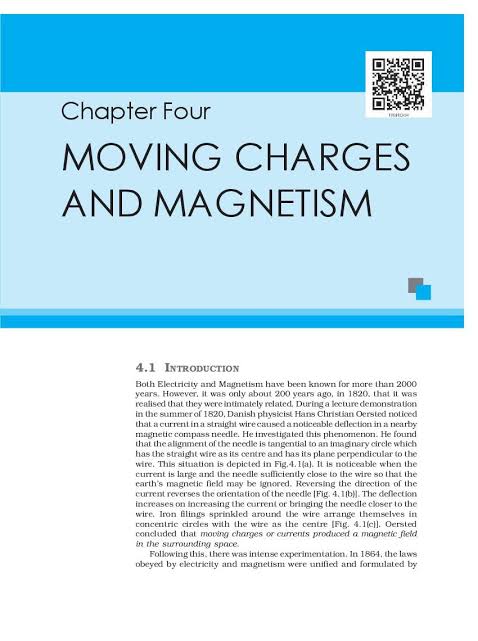
Download books 📚 chapter 4 moving charge and magnetism
Question answer answer ❓
What is the basic principle of an electric motor?
Answer: An electric motor works on the principle that a current-carrying conductor placed in a magnetic field experiences a force. This force is utilized to create rotational motion.
How does a charged particle move in a magnetic field?
Answer: A charged particle moving in a magnetic field experiences a force perpendicular to both its velocity and the magnetic field direction, causing it to move in a circular or helical path.
What is the direction of the magnetic field around a current-carrying conductor?
Answer: The direction of the magnetic field around a current-carrying conductor is given by the right-hand thumb rule, where the thumb points in the direction of the current and the fingers curl in the direction of the magnetic field.
Explain the concept of magnetic flux.
Answer: Magnetic flux refers to the total number of magnetic field lines passing through a given area. It is a measure of the strength of the magnetic field over that area.
Why does a current-carrying loop in a magnetic field experience a torque?
Answer: A current-carrying loop in a magnetic field experiences a torque because the forces on opposite sides of the loop are in opposite directions, creating a couple that tends to rotate the loop.
What happens to a moving charged particle when it enters a uniform magnetic field perpendicular to its velocity?
Answer: When a charged particle enters a uniform magnetic field perpendicular to its velocity, it undergoes uniform circular motion due to the perpendicular magnetic force acting on it.
How is the direction of the force on a charged particle moving in a magnetic field determined?
Answer: The direction of the force on a charged particle moving in a magnetic field is determined by Fleming’s left-hand rule, where the thumb indicates the force, the forefinger the magnetic field, and the middle finger the current direction.
What is the principle of a galvanometer?
Answer: A galvanometer works on the principle that a current-carrying coil placed in a magnetic field experiences a torque, which causes it to rotate. The rotation is proportional to the current passing through the coil.
What is the significance of the angle between velocity and magnetic field in the motion of a charged particle?
Answer: The angle between velocity and magnetic field determines the nature of the particle’s motion. If the angle is 90 degrees, the particle moves in a circular path. If it is less than 90 degrees, the particle follows a helical path.
Why is the magnetic field inside a solenoid uniform?
Answer: The magnetic field inside a solenoid is uniform because the field lines are parallel and equally spaced, resulting in a consistent magnetic field throughout the interior of the solenoid.
What is the role of the magnetic field in the working of a cyclotron?
Answer: In a cyclotron, the magnetic field keeps charged particles in a circular path while the electric field accelerates them. The magnetic field ensures that the particles remain in the cyclotron’s confined space.
Explain why a magnetic force does no work on a charged particle.
Answer: A magnetic force does no work on a charged particle because the force is always perpendicular to the velocity of the particle. Since work is the product of force and displacement in the direction of force, and here displacement is perpendicular, no work is done.
What is the significance of Ampere’s Circuital Law?
Answer: Ampere’s Circuital Law relates the integrated magnetic field around a closed loop to the electric current passing through the loop. It is significant in calculating the magnetic fields of symmetric current distributions.
How does the magnetic field vary inside and outside a long straight current-carrying conductor?
Answer: Inside a long straight current-carrying conductor, the magnetic field increases linearly with distance from the center. Outside the conductor, the magnetic field decreases inversely with distance from the conductor.
Why does a compass needle point towards the Earth’s magnetic north?
Answer: A compass needle points towards the Earth’s magnetic north because it is a small magnet that aligns itself with the Earth’s magnetic field, which points towards the magnetic north pole.
How does the magnetic field affect the path of an electron beam?
Answer: A magnetic field exerts a force on an electron beam, causing it to deflect in a direction perpendicular to both the magnetic field and the electron’s velocity. This deflection is used in devices like cathode-ray tubes.
What is the difference between the magnetic field of a bar magnet and that of a solenoid?
Answer: The magnetic field of a bar magnet is similar to that of a solenoid, but the solenoid’s field is uniform inside and concentrated along its axis, while the bar magnet’s field is stronger at the poles and weaker at the center.
What is a magnetic dipole, and how does it interact with a magnetic field?
Answer: A magnetic dipole is a system with a north and south pole separated by a small distance, like a small bar magnet. In a magnetic field, it experiences a torque that aligns it with the field.
Explain the concept of the magnetic force on a current-carrying conductor.
Answer: The magnetic force on a current-carrying conductor placed in a magnetic field is the result of the interaction between the field and the moving charges in the conductor. This force is perpendicular to both the current direction and the magnetic field.
Why do parallel currents attract and anti-parallel currents repel each other?
Answer: Parallel currents attract because the magnetic fields created by the currents in each conductor align in a way that the conductors are pulled towards each other. Anti-parallel currents repel because their magnetic fields oppose each other, pushing the conductors apart.
Class 12 Chapter 4 handwriting notes PDF solution download
👇👇👇👇
Learn Physics chapter 3 current electricity solution download
👇👇👇👇

Get involved!
Comments